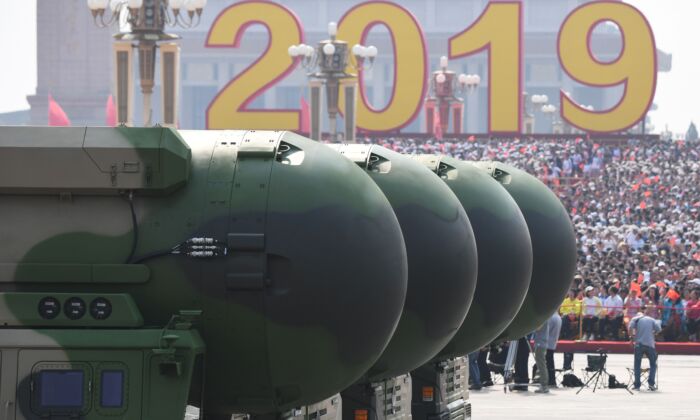The People’s Liberation Army Rocket Force fired the missile at 8:44 a.m. local time on Wednesday and it ‘landed in the predetermined sea area.’
China has test-fired an intercontinental ballistic missile (ICBM) into the Pacific Ocean, its first such test since 1980.
The Defence Ministry in Beijing said Wednesday’s launch was not directed at any country or target and was in line with international law.
The ministry said the missile was launched by the People’s Liberation Army Rocket Force (PLARF) at 8:44 a.m. local time and, “accurately landed in the predetermined sea area.”
The CCP regime said it was a, “routine arrangement in our annual training plan.”
Japan’s Chief Cabinet Secretary Yoshimasa Hayashi told a press conference in Tokyo the Japanese government had not been notified of the launch in advance by China. According to the local Kyodo news agency, Hayashi said the missile did not pass over Japan and did not damage any Japanese ships.
Former Pentagon official Drew Thompson, who now works at Lee Kuan Yew School of Public Policy in Singapore, wrote on X: “China issued a notice to airmen and mariners that the mock warhead would splash down in the Tahiti Flight Information Region, in French Polynesia‘s EEZ. Something for Macron to consider as China proposes a peace plan for Ukraine.”
Thompon added: “The missile’s second and third stages came down near the Philippines. That does not make it a signal specifically for the Philippines. Anything China shoots , flies or sails into the Pacific has to go over or through the first island chain.”
The Chinese military has been increasingly flexing its muscles in the Asia-Pacific region, and has regularly clashed with Taiwan, the Philippines, Japan and Vietnam.
Wednesday’s missile test came as the United Nations General Assembly met in New York. China is one of five permanent members of the UN Security Council and is seeking to gain influence over key departments, including human rights.
Jeffrey Lewis, a missile expert at the James Martin Center for Nonproliferation Studies at the Middlebury Institute of International Studies in California, said: “We’re entering a new age. We’re entering an age where the United States and China are engulfed in what feels like an arms race.”
On Aug. 21, Naval News reported the People’s Liberation Army PLA had launched its most sophisticated non-nuclear submarine to date. Since at least March, the PLARF has had hypersonic missiles capable of delivering nuclear weapons to targets in the United States. The PLARF is building and arming massive silo fields with nuclear missiles in China’s northwest provinces.
An annual arms report published on June 17 by the Stockholm International Peace Research Institute (SIPRI), said China was in the process of significantly expanding and modernizing its nuclear arsenal at a pace that might lead to having more intercontinental ballistic missiles than the United States or Russia in the next decade.
The report said between January 2023 and January 2024, China increased its nuclear stockpile to 500 warheads from 410.
In June, Hans M. Kristensen, associate senior fellow with SIPRI’s Weapons of Mass Destruction Program, said, “China is expanding its nuclear arsenal faster than any other country … in nearly all of the nuclear-armed states, there are either plans or a significant push to increase nuclear forces.”
In February, U.S. Strategic Command Commander Gen. Anthony Cotton told the Senate Armed Services Committee that China had nuclear superiority in Asia.
Cotton stated, “The PRC [People’s Republic of China] has approximately 1,000 medium and intermediate-range dual-capable conventional or nuclear ballistic missiles capable of inflicting significant damage to U.S., Allied, or partner forces and homelands in the Indo-Pacific.”
China conducted its first test firing of an ICBM in May 1980, when it sent a DF-5 missile almost 6,000 miles.
Since 1980, China has conducted hundreds of underground nuclear weapons tests while its neighbor, North Korea has test fired several ballistic missiles, the most recent of which, in December, traveled around 600 miles.
In April, North Korea fired a suspected intermediate missile into the Sea of Japan, drawing condemnation from the United States, Japan and South Korea.
Although China and North Korea are both communist and share some military secrets, it is not clear if there is any coordination of missile tests between Beijing and Pyongyang.
There are nine nuclear-armed states, including the United States, Russia, the United Kingdom, France, China, India, Pakistan, North Korea, and Israel.
Reuters contributed to this report.

